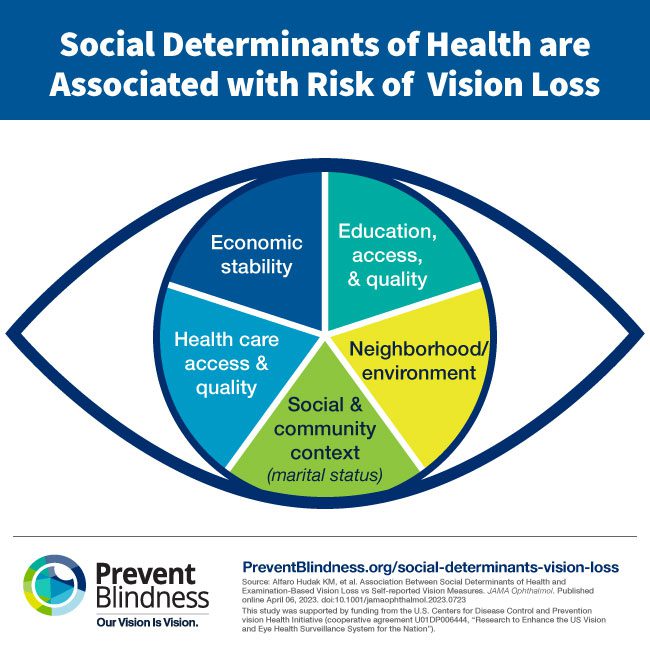A new study from NORC at the University of Chicago, and the Centers for Disease Control and Prevention (CDC), Division of Diabetes Translation, entitled “Association Between Social Determinants of Health (SDOH) and Examination-Based Vision Loss vs Self-Reported Vision Measures” published in JAMA Ophthalmology, found that SDOH across multiple domains were associated with vision loss.
The study also evaluated results from examination-based versus self-reported vision measures. The data showed there were no differences in associations when comparing examination-based and self-reported measures. This is important as self-reported data are collected more frequently than examination-based data, and study results suggest that using self-reported vision data can be used as a proxy measure to track trends in SDOH and vision locally and over time.
Five key domains for SDOH evaluated in the study include:
- economic stability (income, employment status, food security status)
- education access and quality (educational attainment)
- health care access and quality (health insurance, having a primary care provider or routine place to go for health care)
- neighborhood and built environment (owning a home, living in an urban or rural residence)
- social and community context (marital status)
People with higher odds of vision loss include those persons who were widowed, divorced, separated, or never married. Individuals with Medicare, Medicaid, other government insurance recipients, or those who have no insurance had 22-155 percent higher odds of vision problems compared to persons with private insurance. Non-Hispanic Black, Hispanic, or non-Hispanic other race/multiracial individuals had higher odds of vision loss than non-Hispanic White individuals. Additionally, those with low or very low food security had significantly higher odds of self-reported poor vision.
Conversely, individuals who were employed, had higher levels of income and education, owned a home, or had a primary care physician, had lower odds of vision loss.
“Examination-based measures are still the gold standard, but because of their cost they are collected less frequently, and do not have the sample size and coverage to capture geographic variation at the state and county level.” said Katelin M. Alfaro Hudak, PhD, MID, NORC at the University of Chicago, and the lead author of the study. “Our findings increase our confidence in estimates using self-reported measures when examination-based measures are not available.”
Study estimates will be summarized on the CDC’s Vision and Eye Health Surveillance System (VEHSS). The Vision and Eye Health Surveillance System (VEHSS) creates composite estimates of the prevalence of vision loss and major eye disorders. The VEHSS composite estimates represent the primary surveillance measures of cumulative diagnosed and undiagnosed disorders developed by VEHSS.

